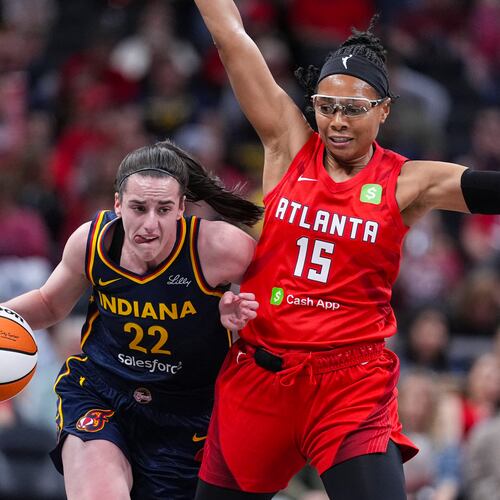For the Georgia or Georgia Tech fan fuming over the shortage of five-star recruits in the signing class and for the unrated running back headed for an FCS school, a word of caution from Falcons quarterback Matt Ryan regarding recruiting rankings.
“Can’t trust those,” he said with a smile.
Before he began his authorship of the quarterback chapter of the Falcons record book and was twice selected to the Pro Bowl, he was Matt Ryan, three-star quarterback. When he made final his college choice on national signing day in 2003, recruiting website Rivals deemed that Boston College was receiving the No. 25 pro-style quarterback in the country. While the assessment has proven a bit light, Ryan the teenager was hardly insulted.
“I thought it was pretty good,” Ryan said. “In high school, if you’re ranked in the top 25, it’s not bad, you know?”
Still, Ryan has been a bit better than advertised, starting at Boston College, where he became the 2007 ACC player of the year and won the Manning and Johnny Unitas awards. As a Falcon, his outperformance hardly makes him unusual. Of the 22 starters in the NFC championship game, seven Falcons were rated three-star players or lower by Rivals. That doesn't include nine players whose high school careers preceded Rivals' existing records.
On the entire roster, some players weren’t even rated, like backup defensive end Kroy Biermann.
“It is an inexact science,” said longtime high school scout Tom Lemming, of CBS Sports Network. “We’re dealing with a couple million kids. The NFL deals with a couple hundred.”
Players that Rivals tabs as five-stars are projected to be All-Americas and first-round NFL picks, said Mike Farrell, national recruiting analyst for Rivals. Four-stars are high-impact players and all-conference picks. Three-stars are one- or two-year starters but not high-impact players. Two-stars are projected as “depth-chart guys,” Farrell said.
The grades come from a team of national scouts and dozens of team-based reporters who watch game video, practices, all-star games and camps. Farrell acknowledges the subjectivity inherent in the process.
Said Farrell, “All things being equal, the difference between (No.) 24 and 25 is nothing.”
Of the 24 pro-style quarterbacks ahead of Ryan in the 2003 class, four eventually were drafted and only three have played in the NFL – JaMarcus Russell, Brady Quinn and Matt Flynn. The other gem in the top 50 besides Ryan was 14 spots below him at No. 39 – a quarterback from Audubon, N.J., named Joe Flacco, who only found collegiate success after transferring from Pitt to Delaware.
Flacco and Ryan truly proved the exceptions. Only four ahead of Ryan won all-conference honors in college – Russell at LSU, Andre Woodson at Kentucky, Drew Tate at Iowa and Todd Boeckman at Ohio State. Most didn’t play significantly in college, washed out by injuries or better competition.
“I think in high school, you can survive on talent,” said guard Peter Konz, a four-star prospect as a high school senior in Wisconsin. “The further you go, as it is with everything, there has to be more work, more drive. You have to want to do it.”
There were plenty of hits, obviously. Wide receiver Julio Jones and guard Justin Blalock, the only two Rivals five-stars in the starting lineup, were additionally the top players at their positions. Outside linebacker Akeem Dent was a four-star, the No. 12 outside linebacker in the country in 2006. Back before websites like Rivals and Scout mushroomed interest in recruiting, Lemming found the top tight end in the country in the 1994 class in Southern California.
“Tony (Gonzalez) was on the cover of my magazine as one of the top five players in the country,” said Lemming, who publishes the annual Prep Football Report.
For Konz, being named a four-star – the 30th ranked offensive tackle in the 2008 class and the No. 2 player in Wisconsin – was a blessing on his way to becoming a four-year starter and an All-America as a senior.
“It does give you confidence,” he said. “It makes you feel good. It makes you believe that you can do something good in college and be a starter.”
On the flipside, being dismissed gave others fuel. Backup tight end Michael Palmer was disappointed to receive two stars coming out of Parkview High in Gwinnett County. Other Falcons two-stars – that is, players expected to fill out depth charts of their college teams, not start for NFL division champions – were outside linebacker Sean Weatherspoon (who was not judged one of the top 60 outside linebackers in the same class as Dent), defensive tackle Vance Walker and safety Thomas DeCoud.
“It’s still crazy when I think back on it, because I was a first-team all-state tight end in Georgia and I had a really good junior and senior year, but got two stars,” he said.
Palmer received only one BCS conference scholarship offer, from Clemson. Other schools showed interest, but “they always ended up offering another kid,” Palmer said. The rating and the lack of scholarship offers motivated him, both at Parkview and at Clemson, to show that he was a legitimate FBS talent. He went on to become an All-ACC tight end in 2009 and made the Falcons in 2010 as an undrafted free agent.
“When I got to Clemson, I’d ask, How many stars did this guy have, guys on my team and guys on other teams in the ACC and at other schools,” he said. “I’d be like, You’re telling me that guy got a five-star?”
If the Falcons are any evidence, the question will likely never stop getting asked.
About the Author
Keep Reading
The Latest
Featured


